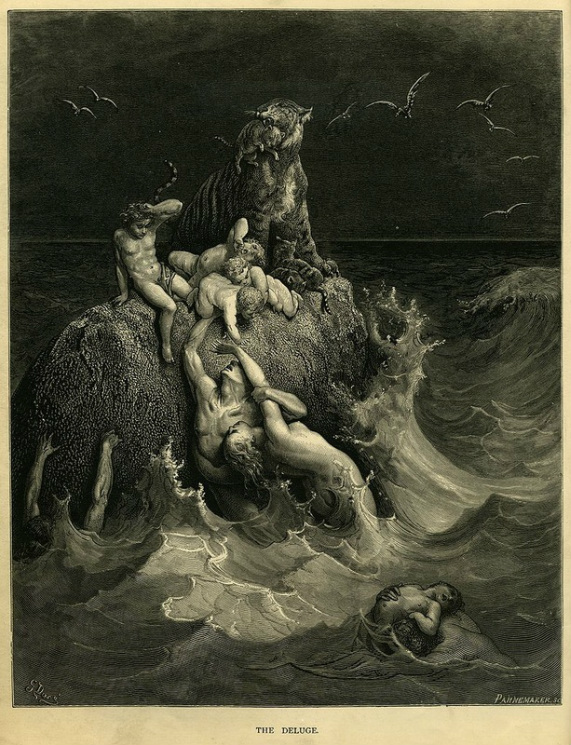home > questionable doctrine > flood
The Global Flood of Noah
Watchtower interprets the Genesis account of a global flood literally, postulating that water covered the top of earth's highest mountains. This article addresses an array of evidence regarding whether it is possible that a global flood occurred 4,400 years ago.
This article specifically concentrates on Watchtower's interpretation of the Flood of Noah, an account from Genesis chapters six to nine. Watchtower calculates Noah's flood to have occurred in 2370-2369 B.C.E. (w09 7/1 p.13), around 4,400 years ago.

After 40 days of constant rain, the entire planet was flooded, covering the tops of earth's highest mountains. After several months, God caused the waters to subside and the ark came to rest in Turkey on the "mountains of Ararat", or Ağrı Dağı, with peaks over 5 kilometres high. Almost all life on earth was drowned, with only eight humans surviving, along with the small assortment on animals that were able to fit on an ark. After exactly one year, Noah and the animals left the ark, entering a barren world, apart from the regrowth of some vegetation. Although the arguments presented for a flood are from Watchtower publications, little of this originates with Watchtower writers, but borrows heavily from fundamental Christian sources.
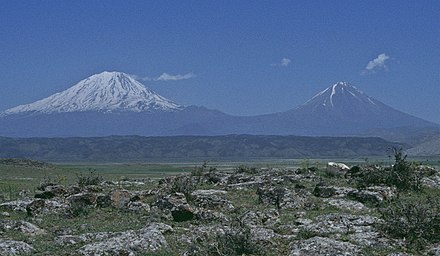
Following are key areas to consider when deciding if a global flood is possible, presented in layman's terms. The footnotes link to sources providing more detailed research behind each topic.
Size of Ark
The dimensions provided in the Bible for the length of the ark raise two issues. On the one hand, it was too long to be water tight if constructed from wood. On the other, it was small by modern standards, too small to fit all moving animals and flying creatures.
Too big for a wooden ship
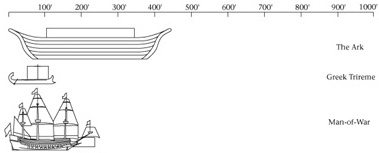
Small compared to modern steel ships
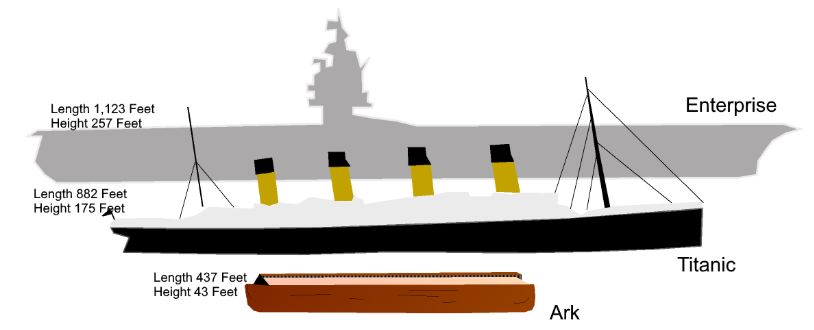
The maximum length of any known wooden boat is only 115 meters. This is considered the physical limit for wooden boat construction, because at this length it is not possible to prevent wood flex and leakage. Ships built with a length of 100 meters during the 1800's suffered problems with leakage, despite being reinforced and braced with steel. The ark is said to be 300 cubits, or 134 metres long (438 feet). It is only since the invention of steel shipbuilding that the size of ships has increased dramatically.
If there was an ark built to the length given in the Bible, it is unlikely to have been water tight, even with today's technology. Noah had the added issue of living at the beginning of the Middle Bronze Age, with very primitive tools, made from soft metals. This would exacerbate the problem of shaping the wood to strict tolerances.

The stresses placed on the ark were also more than would usually be experienced by a ship. The ark was not required to just float as a barge, but withstand massive water turbulence from the flood. The volume of water required to flood the earth above mountain level in 40 days would mean torrential rains, raging rivers from mountain run off, and huge violent seas. This would put tremendous strain on a ship already past the limit of the materials it was constructed from.
Watchtower has acknowledged that this length is considered unlikely for a wooden ship, however not in relation to the ark but regarding an account of Chinese ships.
“Zheng He’s Treasure Ships—How Large and How Many?
Historical records from the Ming dynasty say that Zheng He’s treasure ships were amazingly large—447 feet (136 m) long and 183 feet (56 m) wide. Scholars find these figures problematic and hard to verify, in that wooden sailing ships in excess of 300 feet (90 m) in length are structurally unsound. “All indications are that exaggeration has been at work in the accounts that mention the ships’ enormous size,” says one article on the subject. “A ship of about 200-250 ft [60-75 m] would make much more sense than the 450 ft [135 m] one.”” Awake! 2013 Sep p.15
Wikipedia - List of world's largest wooden ships
Watchtower article on length of the Ark - Awake 2007 Jan pp.20-22
At 134 metres the ark was too large to function as a wooden vessel, yet was small by modern standards. It was less than half as long as the Titanic, and just one third of the length of Triple-E container carriers, which are 400 metres long. This raises the next issue of just how many animals could have fit.
Number of animals
There are over 8 million species on earth.4 These are broken down into:
- "~7.77 million species of animals (of which 953,434 have been described and cataloged)
- ~298,000 species of plants (of which 215,644 have been described and cataloged)
- ~611,000 species of fungi (moulds, mushrooms) (of which 43,271 have been described and cataloged)
- ~36,400 species of protozoa (single-cell organisms with animal-like behavior, eg. movement, of which 8,118 have been described and cataloged)
- ~27,500 species of chromista (including, eg. brown algae, diatoms, water moulds, of which 13,033 have been described and cataloged)" sciencedaily.com - 24 Aug 2011
Don't forget about insects and spiders. 46,000 species of spider have been discovered so far - USA Spiders (16 Feb 2021). How Many Species of Insects and Other Terrestrial Arthropods Are There on Earth? Nigel E Stork Jan 2018 suggests there are approximately 1.5 million beetles, 5.5 million insects, and 7 million terrestrial arthropods.
We need to go smaller still to the world of viruses. Did Noah's family carry the fore bearers of all human viruses?
Genesis says "every" animal was housed on the ark, either represented as a couple or a group of seven, along with seven of each flying creature.
"Of every clean beast you must take to yourself by sevens, the sire and its mate; and of every beast that is not clean just two, the sire and its mate; also of the flying creatures of the heavens by sevens, male and female, to preserve offspring alive on the surface of the entire earth." Genesis 7:2,3
Genesis says the ark housed a representative of every animal, of which there is an estimated 8 million species. When indoctrinating children, Watchtower literature also claims every animal made it onto the ark.
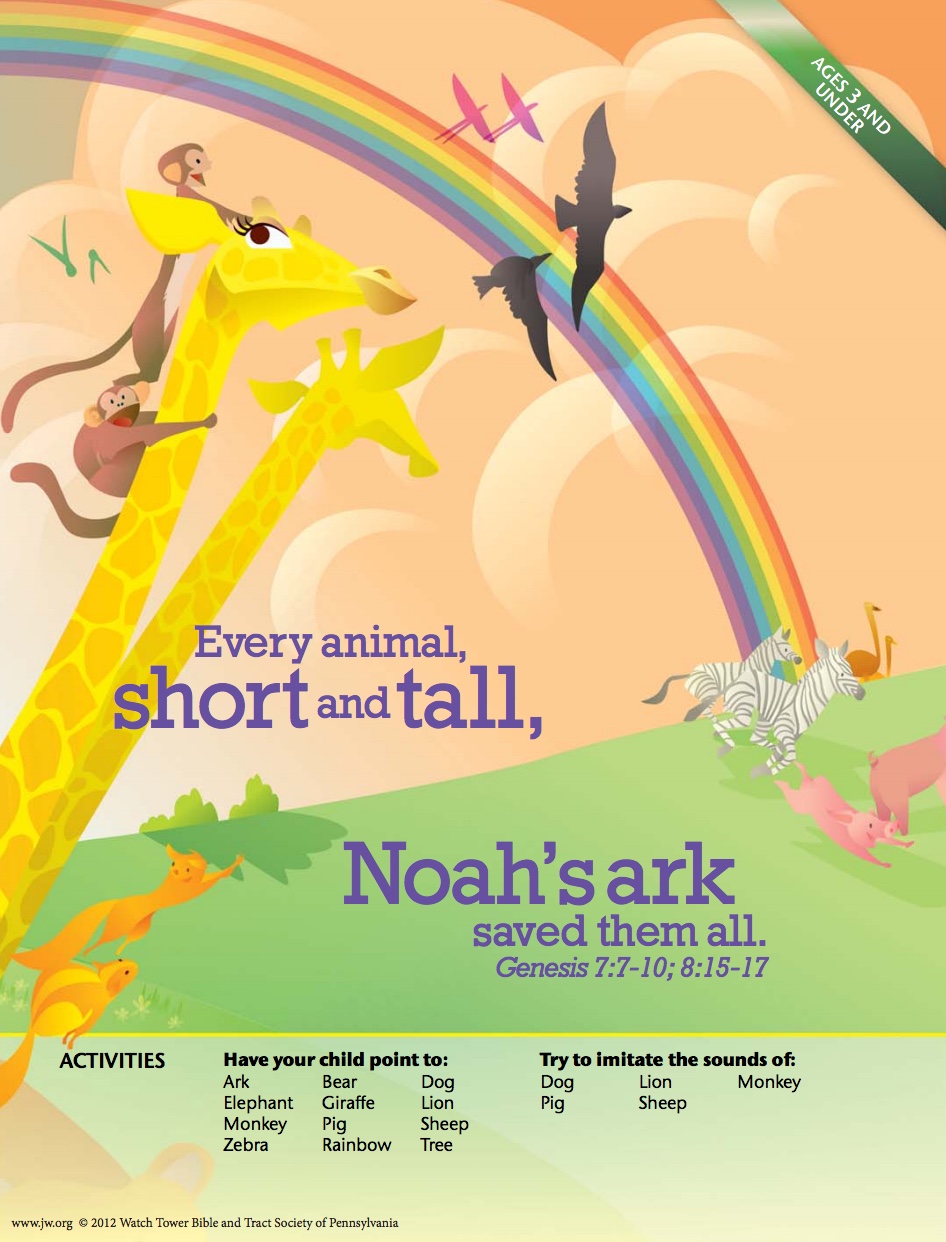
Since adults are not as gullible as children, Watchtower has found it necessary to explain that "every" animal means only a minute subset of animals. Since fitting 2 of each animal is impossible, the Watchtower speculates that Noah did not need to take representatives of every species, but only of each "kind", a term taken from Genesis that the Watchtower claims refers to animal breeding boundaries.
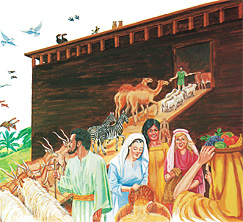
"The breeding boundaries according to “kind” established by Jehovah were not and could not be crossed. With this in mind some investigators have said that, had there been as few as 43 “kinds” of mammals, 74 “kinds” of birds, and 10 “kinds” of reptiles in the ark, they could have produced the variety of species known today. Others have been more liberal in estimating that 72 “kinds” of quadrupeds and less than 200 bird “kinds” were all that were required. That the great variety of animal life known today could have come from inbreeding within so few “kinds” following the Flood is proved by the endless variety of humankind—short, tall, fat, thin, with countless variations in the color of hair, eyes, and skin—all of whom sprang from the one family of Noah." it-1 pp. 164-165
For instance, cats belong to the family Felidae, of which there are 15 genus and 41 known species. For sake of space, the Watchtower proposes only one member of the 15 genus could have been taken, or maybe even only one of the Felidae family. The 41 species evolved from there. This is a handy theory, but not in line with Genesis, in which Noah is told to take representatives of "every" beast and flying creature.
Other global flood advocates reduce the number of animals required on to ark to 16,000 animals. (See answersingenesis.org 28 Sep 2012). The same Insight section quoted above on kind went on to also lend support to this higher number.
"These estimates may seem too restrictive to some, especially since such sources as The Encyclopedia Americana indicate that there are upwards of 1,300,000 species of animals. (1977, Vol. 1, pp. 859-873) However, over 60 percent of these are insects. Breaking these figures down further, of the 24,000 amphibians, reptiles, birds, and mammals, 10,000 are birds, 9,000 are reptiles and amphibians, many of which could have survived outside the ark, and only 5,000 are mammals, including whales and porpoises, which would have also remained outside the ark. Other researchers estimate that there are only about 290 species of land mammals larger than sheep and about 1,360 smaller than rats. (The Deluge Story in Stone, by B. C. Nelson, 1949, p. 156; The Flood in the Light of the Bible, Geology, and Archaeology, by A. M. Rehwinkel, 1957, p. 69) So, even if estimates are based on these expanded figures, the ark could easily have accommodated a pair of all these animals." it-1 pp. 164-165
Even with these dramatically reduced numbers, it is preposterous to say they could "easily" be accommodated in the ark, and the Watchtower has put no effort whatsoever to identify what would be involved in housing and caring for such numbers of animals.
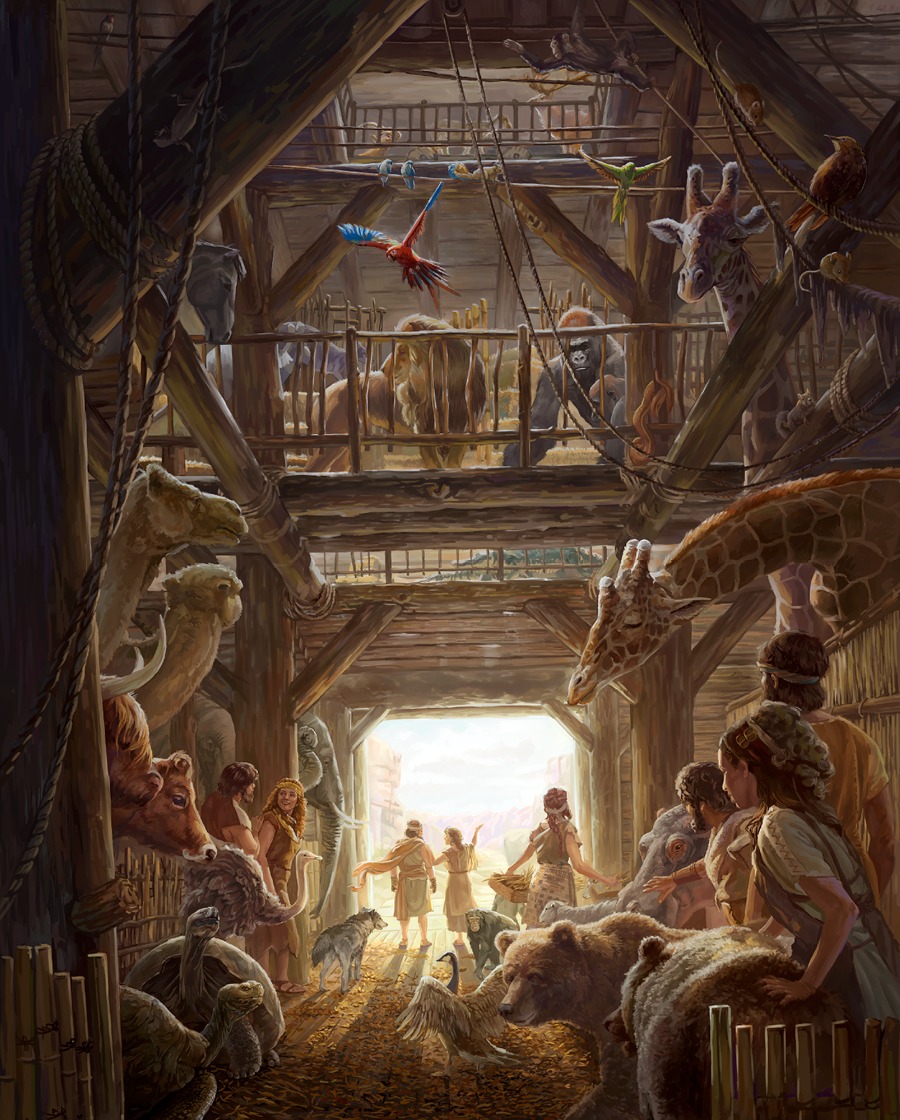
Lessons You Can Learn From the Bible - Lesson 6
As a thought experiment, contemplate rescuing the world's animal population on a ship smaller than the Titanic, even if it was just 16,000 species? Imagine the amount of work for eight humans. A zoo requires many times more humans to cater for far smaller numbers of animals. For example, maintaining Taronga Zoo requires over 1,000 employees. (2018 Annual Financial Report )

Image Source: reddit.com/user/kid_epicurus
Contemplate the amount and smell of manure and vomit as a result of the violent water turbulence and disease. How did the animals have room to exercise? Animals have specific dietary requirements. How did Noah collect the various fruit varieties required, and keep them from rotting for over a year? Where was the incredible volume of 12 months supply of food and drinking water kept and what prevented it from going putrid over such a long period of storage? A single elephant requires over 100 litres of water a day, and a similar weight of food. Ventilation windows were small and only on the upper deck, providing inadequate levels of oxygen, and trapping carbon dioxide and methane. Amidst all of that, Noah's family would have spent the entire time transporting food between the three decks and shovelling manure from the top-level windows.
After the flood and loss of most animal life by means of the heartless drowning of billions upon billions of innocent creatures, what was the first thing Noah decided to do with his precious cargo upon leaving the ark?
Genesis 8:20-21 "Then Noah built an altar to Jehovah and took some of all the clean animals and of all the clean flying creatures and offered burnt offerings on the altar. And Jehovah began to smell a pleasing aroma."

Joseph Anton Koch Landscape with Noah
Once the animals disembarked, the ground would have been largely devoid of vegetation, since it had all drowned. Even though some vegetation may have survived and regrown, the entire range of animal's special dietary requirements was not at Mount Ararat, and it would have taken years for animals to reach their natural habitats.
What about the predators, what did they eat? They could not have eaten their natural prey whilst there was still only two of each. How many decades before the animal populations reached sustainable levels so that they could become food again? There is an alternate thought presented by the Watchtower that animals were all vegetarian, but that leads to another problem shown next.
Taking every animal on the ark is impossible when considering a global population of 8 million animal species, but makes sense if Genesis was referring to a local flood and was discussing the entirety of animal life in the region.
Marsupials and Animal Diversification
The next question to arise is how the animals got to the ark. Watchtower illustrations show animals from around the globe arriving at the ark, including African rhinos, antarctic penguins and Australian kangaroos. Are we expected to believe animals adapted for vastly different climates were all living in the Middle East prior to the flood, or that they took global journeys to liaise at Noah's meeting point just as the flood hit? (Surely the simultaneous convergence of thousands of animal species at the ark would have given local residences an inkling that Noah may just be right about God's coming deluge.)
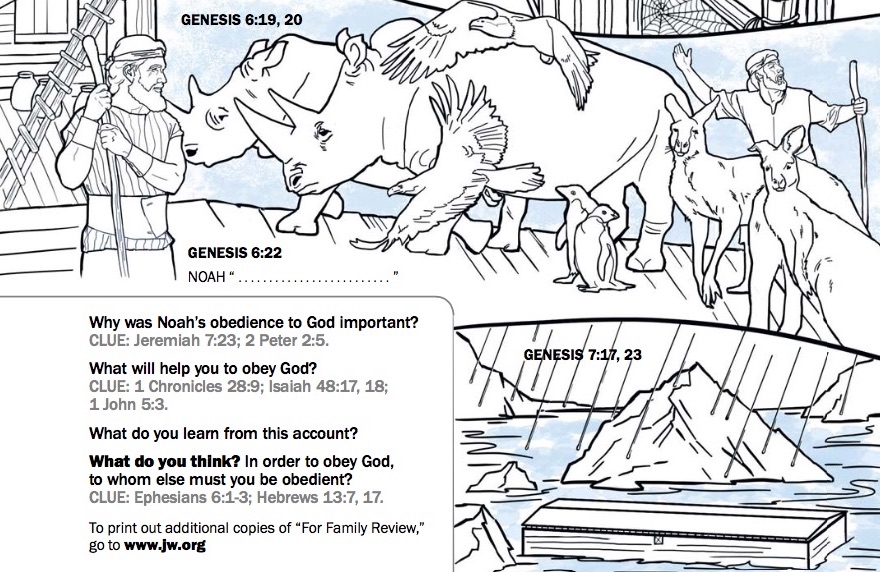
Australian marsupials provide a visualisation of another issue with a global flood. Koala's were in Australia prior to the flood, as fossils exist of the koala and giant Koala, dating back 50,000 years to the Pleistocene period. The story of the ark requires a koala couple to somehow make their way from Australia to the ark in the Middle East. The koala has a strict diet of eucalypt leaves, which are toxic to most other animals, so they needed to travel with a sufficient supply of eucalypt leaves for the journey, year long captivity upon the ark, and trip back. After the floodwaters subsided, the koala pair tracked back to the Southern hemisphere island continent of Australia, with their remaining supply of old eucalypt leaves. Along the way, the Koala did not leave behind any relatives, and remarkably traversed several hundred kilometres of water between Indonesia and the tip of Australia.

Koalas were not alone, as hundreds of species would also be required to make this amazing sea voyage. Marsupials live predominantly in the Southern Hemisphere. Koalas and kangaroos are only found in Australia and the Tasmanian devil exists only on the small island of Tasmania, at the southern most part of Australia.
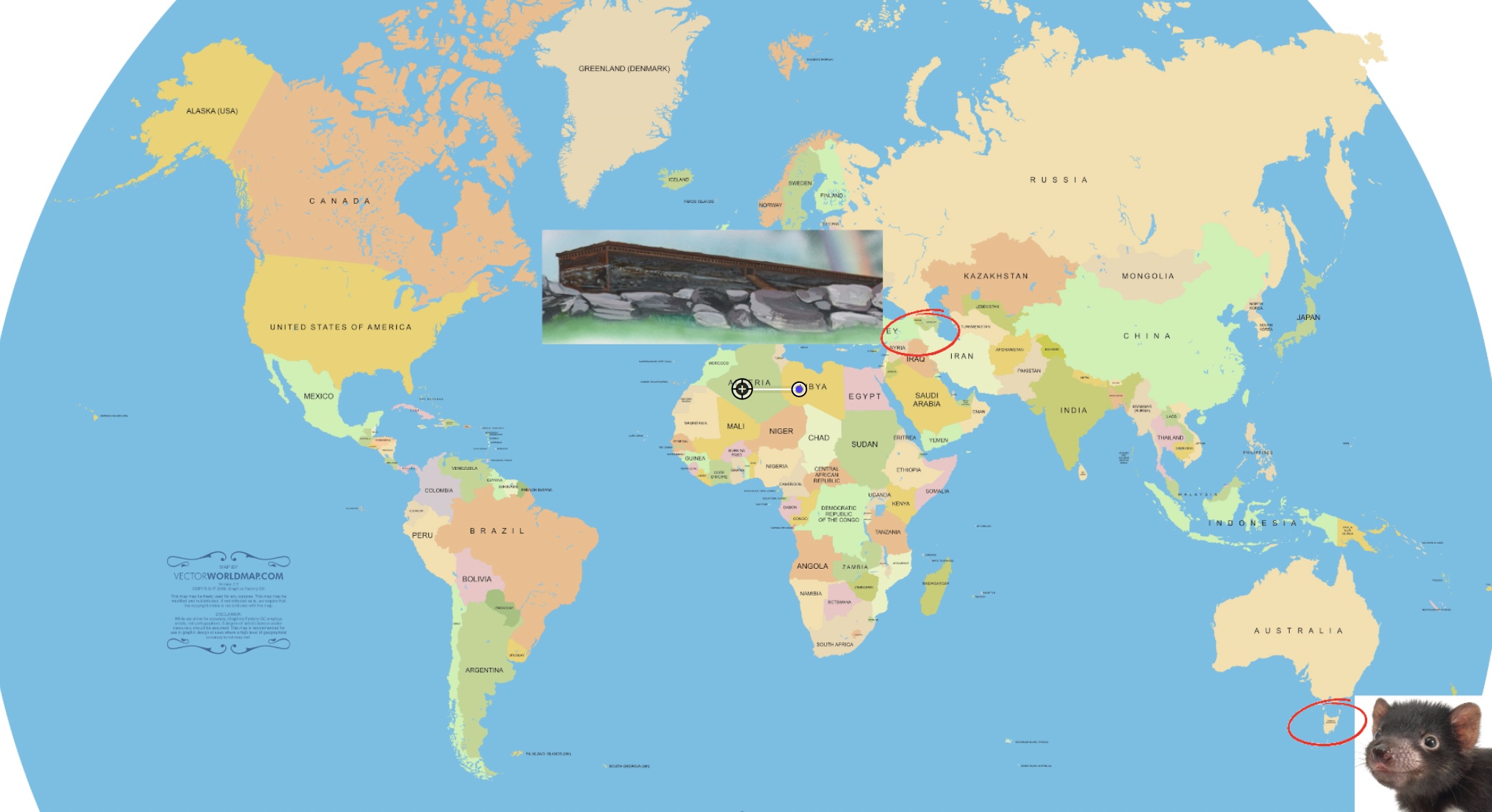
Even rarer are monotremes, marsupials that lay eggs. There are only two, the echidna and platypus, and as the Awake! highlights, they are only found in Australia.
"... only two monotremes. Both are found only in Australia." Awake! 1970 Jul 22 p.11

Image Source: Awake! 1970 Jul 22 p.12
It is amusing to think the platypus could travel any substantial distance knuckle walking on it's webbed feet.
Unique Australian wildlife includes insects and spiders. The dancing peacock spider is native to Australia. If it was on the ark, how did it traverse it's way back to Australia? Did it evolve within the last 4,000 years from some other spider species? Both options are implausible.

Watchtower uses the argument that a land bridge existed for marsupials to cross.
"Some have contended that the presence of animals on isolated islands like Australia and New Zealand is an indication that not all land animals outside the ark perished in the Deluge. However, the findings of oceanographers indicate that at one time land ridges connected what are now isolated land areas. For example, oceanographic studies indicate that the Mid-Atlantic Ridge may have crossed that ocean above the surface. Possibly there were also other ridges, and animals could have migrated by means of these before such ridges sank below the surface of the ocean. Other oceanographic studies have turned up evidence that once there existed a huge South Pacific continent that took in Australia and many of the South Sea isles. If such was the case, then, of course, the animals had no difficulty in migrating to these lands." it-1 pp.110-112
The Watchtower is misusing the evidence for land bridges, as oceanographic studies show the separation of continents is happening at a matter of centimetres per year, not hundreds of meters, as would be required if Australia separated from the other continents a mere 4,000 years ago. Ironically, in an article criticising Young Earth Creationists, the Watchtower contradicts its own flood dispersion theory.
"Their [Creationist] teaching that the earth and even the universe are less than 10,000 years old contradicts all the findings of modern science. They are so far out of step that they invite ridicule from scientists. Geologists can point to their measurements of geologic processes that extend far beyond that narrow time frame. Ocean sediments have accumulated over far more than 10,000 years. The time to build mountains and wear them down is measured in millions of years. For continents to drift apart and form oceans takes hundreds of millions of years. To say that all of this goes back only 10,000 years is simply absurd in the eyes of geologists." Awake! 1983 Mar 8 p.14
Remember that Watchtower quote, as it undermines several arguments from the Watchtower for proving a flood, and will be discussed later.
Species distribution and diversity contains countless problems for a global flood. It is not only Australian marsupials, but pockets of animal life around the globe that keep raising this issue. Over 90% of the wildlife on Madagascar, an island in the Indian ocean, is found nowhere else on earth, such as its 100 species of renowned lemurs, and 80 percent its 14,883 plant species, including 5 unique plant families.
Socotra, a small island 240 kilometres from Africa in the Indian Ocean, contains a number of reptiles and birds endemic to the island. Furthermore, one third of its plant life, over 700 species, are unique to the island, including Dracaena cinnabari, the dragon's blood tree.

Penguins live predominantly in the Southern Hemisphere. With their stumpy legs they would have had a terrible time traversing down Mount Ararat to the sea, before starting off on a 13,000 kilometre ocean swim to Antarctica.

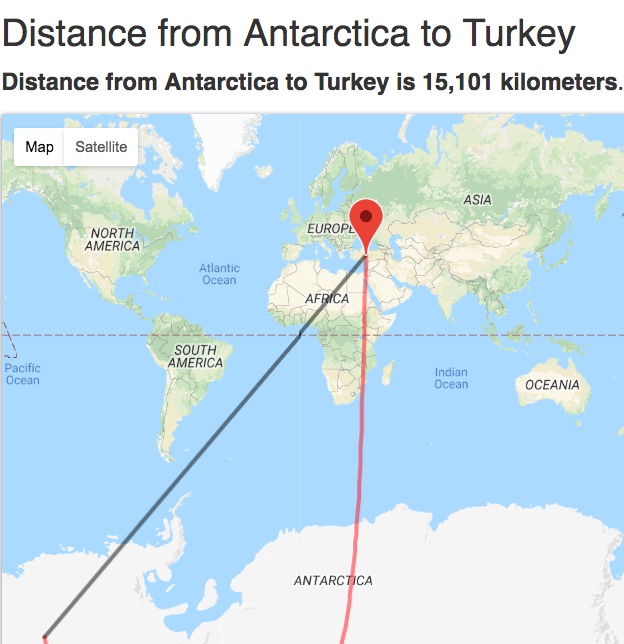
Other than invoking a divine transportation miracle, how did the animals travel to these islands, and what did they eat along the way, when they have highly specialised diets and climate requirements? Why are endemic plants found nowhere else? This is compounded by the limited number of species that could be carried on the ark, as discussed later. The only way to account for this is to believe in rapid evolution of small samples of species on these islands, a concept global flood apologists are usually averse to, and considered impossible by scientists.
Botany
There are over 900,000 pecies of plants, fungi, protozoa's and chromistas. (sciencedaily.com - 24 Aug 2011) How did they survive, considering the majority were not taken onto the ark with Noah?

Bristlecone pine. Image attribution: ross_schram
How is it that there are cresote bushes that have lived for over 10,000 years? Dendrochronology shows some Bristlecone pine trees are over 4,800 years old (Rocky Mountain Tree Ring Research rmtrr.org/oldlist.htm as of 11 Apr 2021). These would not have survived the violent flood waters and mire of mud, or a year-long period of burial under the pressure of several kilometres of salty brine.
Most plant life would have drowned. When the waters subsided, the ground would have a coating of salt, after the salty brine evaporated, making regrowth virtually impossible for most vegetation. Even if plants could regrow under such conditions, it would take several months to grow the new crops and fruit that were required for the variety of diets of the animals coming off the ark.
Fish
The majority of fish are either salt water, or fresh water. Place a teaspoon of salt in a freshwater tank and watch the fish die. Catch a fish from the sea and place it in a freshwater tank and it too will die. Whilst euryhaline fish can live in both salt and fresh water, most fish can only survive in either salt or fresh water, being highly sensitive to changes outside their specific saline tolerance.
The huge volume of torrential freshwater rain, and merging of lakes and oceans, would have created a salty, muddy brine uninhabitable for both freshwater and saltwater fish, along with all other forms of sea life that were not on the ark, such as crustaceans, whales and amphibians. Virtually all sea life would have perished.
The Genesis account is quiet about fish, not accounting for the affect of a global flood on them. Although the statement to bring onto the ark "every living creature of every sort of flesh" in Genesis 6:19 may encompass fish, verse 20 specifically only includes "flying creatures … domestic animals … [and] all moving animals of the ground". 2 million animal species live in the oceans, how did they survive?
Coral reefs

Coral develops slowly. Australia's Great Barrier Reef dates back tens of thousands of years, with the current living reef estimated at between six to eight thousand years old. Most corals grow in clear, shallow water and require sunlight to live. They are sensitive to change and die with water temperature movements as minor as just 2 degrees Celsius and slight salinity changes. Most can only live in water less than 50 meters deep. The coral world would have been destroyed by the flood and could not have regrown to its present state within just 4,000 years.
Rapid Evolution
If we are to accept that the ark accommodated 16,000 animals for a year (under 8,000 species as they were in pairs), we are confronted with the problem of explaining how there are now over 8 million species. For Noah's fleet to expand from 8,000 species to 8 million in just 4,400 years demands believing in hyper evolution. Even the most optimistic evolutionist would not espouse such figures.

Consider again the Felidae family, and in particular Panthera Genus. Jaguars are native to Latin Amercia, Lions to Africa and Tigers to Asia. The Global Flood interpretation claims the there was a single Felidae couple on the ark. After leaving the ark, their litter of cubs must have spread to these three different continents. Within 2,000 years that single Panthera family had to have evolved into 3 strikingly different and unique Genus, since Lions and Tigers already existed in the time of Jesus.
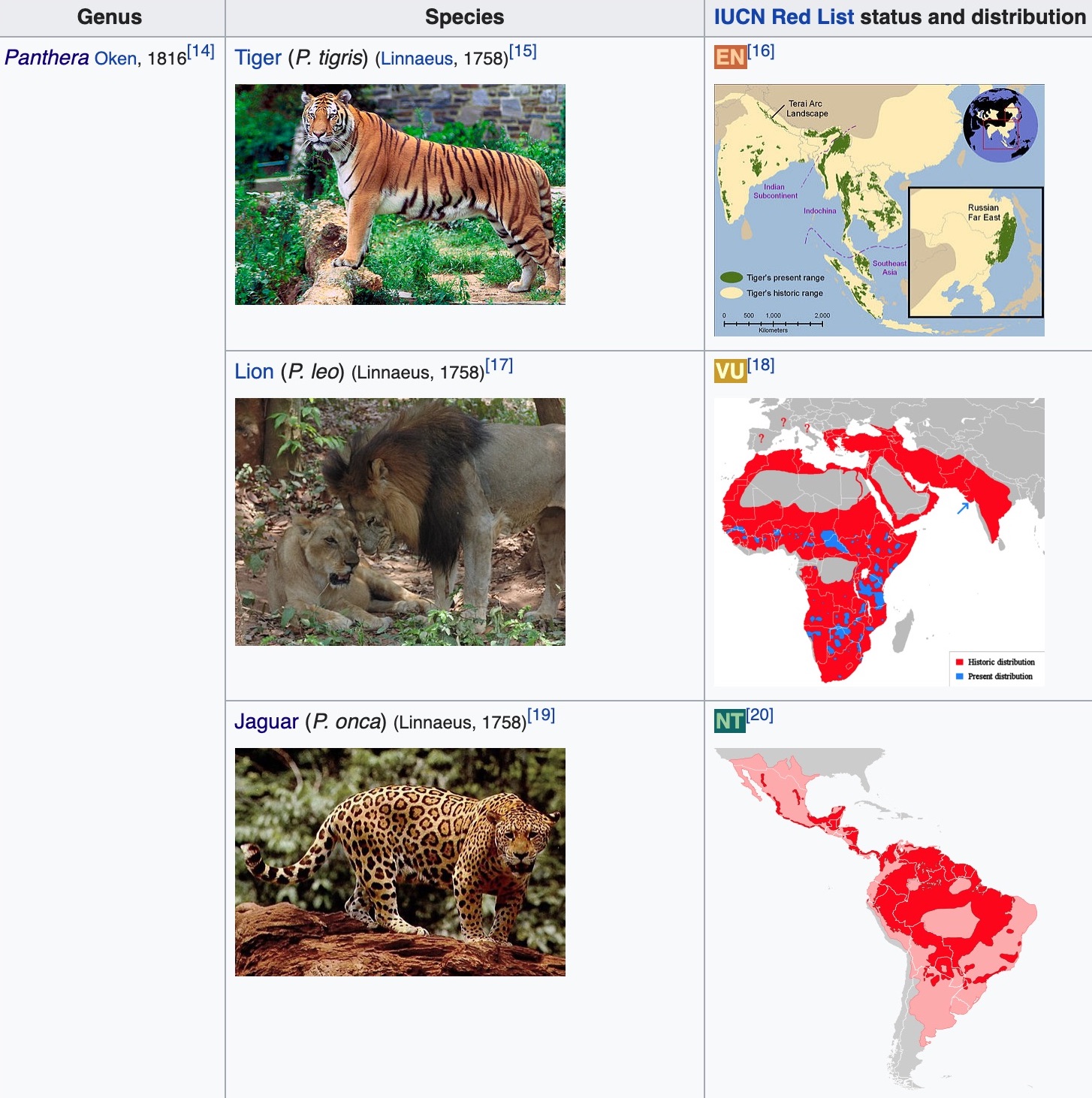
There are two critical points to acknowledge here. Firstly, is simply impossible for the offspring of a single cat to have evolved into lions, tigers and jaguars within 2,000 years. Secondly, lions, tigers and jaguars were around well before Noah's flood, as proven by cave art, ancient manuscripts and fossils. This is the case for numerous animal species. Not only is it impossible for a few thousand species to evolve into a few million within 4,000 years, there is ample evidence that more than a few thousand species living today were around long before the time of Noah.
There are still more flaws in Watchtower's argument. Watchtower articles commonly point to a particular features on an animal as proof of intelligent design, yet a global flood means that the majority of individual features were not designed by an intelligent creator, but evolved explosively over the last few millennium. Teeth are one such feature.
Teeth provide a strong indication of the food an animal eats, such as incisors on meat eaters. Watchtower claims animals were vegetarian prior to the flood and only given authority to eat meat after exiting the ark.
"After the flood of Noah’s day, God set out a change from the vegetarian diet that he had outlined for animals and humans in the garden of Eden." Watchtower 1982 Jun 15 p.31
"As a concession for his survival, man was authorized to eat animal flesh as food after the Flood. (Gen. 9:2-4) The animals, too, coming into chaos, began to live off one another." Awake! 1981 Oct 8 p.27
If this was true, meat eating animals did not have incisors until after the time of the flood. In actual fact, the fossil record shows incisors existed well before the period of the flood. Watchtower seems aware of this problem, with the 1981 Awake! article above going on to bizarrely speculate that God had unnecessarily created animals with "certain features" (incisors) that they adapted to using after the flood.
"And since God had created a vast variety of features to make animal life interesting, many animals would be able to adapt to their new situation by using certain features to assist in their survival." Awake! 1981 Oct 8 p.27
Watchtower proposes that the world was covered in a vast cloud canopy prior to the flood
"Where did the water causing the global Flood come from? During the second creative period, or “day,” when the earth’s atmospheric “expanse” was formed, there were waters “beneath the expanse” and waters “above the expanse.” (Genesis 1:6, 7) The waters “beneath” were those already on earth. The waters “above” were huge quantities of moisture suspended high above the earth, forming a “vast watery deep.” These waters fell upon the earth in Noah’s day." Watchtower 2004 Jan 1 p.30
The result would be a tropical climate spanning the globe. This is contradicted by articles that claim God had created Arctic animals designed for the snow.
"A dozen arctic ground squirrels appear to have set a record—when their body temperature dropped to 26.8 degrees Fahrenheit (-2.9°C)! At that temperature, we would expect their brains to freeze. How does the arctic ground squirrel survive? … What do you think? Did the arctic ground squirrel’s resilient brain come about by evolution? Or was it designed?" Awake! 2013 Jul p.16
The human races must have evolved quickly too. There are 3 basic races, Caucasian, Mongolian and Negroid. (Some classifications include Australoid as a fourth race.) These are then subdivided up to 30 subgroups. Watchtower claims Noah's sons represented each of these races.
"The threefold division of the human family into the Japhetic, Hamitic, and Semitic races, all descending from Adam through Noah, cannot be successfully disputed. (Ge 9:18, 19; Ac 17:26)" it-1 pp.307-313
It is interesting to consider that Noah's wife was able to miraculously conceive three sons of such genetic diversity. Surely, it would be more scientific to link the genetic differences to the wives. Either way, the thirty subgroups are supposed to have developed within 4,400 years, something even evolutionists would not be willing to propose, and is proven false by genetics.
Genetic Diversity
It is common knowledge that close relatives should not breed, due to an increased risk of birth defects. If the global population of animals was reduced to just two of each kind 4,400 years ago, there would be a forced inbreeding program, and evidence of such.
An indication of genetic variability is manifest in transplants, where the risk of rejection increases according to the degree of genetic disparity between the donor and the recipient. MHC proteins on a cell distinguish "self" from "non self" and lead to organ rejection. A case in point is the cheetah. Low genetic variability amongst cheetahs show they all link back to just a few breeding pairs, with scientists believing the cheetah almost went extinct about 10,000 years ago. The cheetah population has a low MHC protein variation and this genetic similarity allows skin grafts between unrelated cheetahs to be accepted. The downside of this genetic inbreeding is low sperm counts and high levels of birth defects. The danger is that, having similar immunities, cheetahs are susceptible to extinction from a common disease. Animal species with greater genetic diversity are more likely to have some with immunity to a disease that others do not have. (See O'Brien, S., D. Wildt, M. Bush (1986). "The Cheetah in Genetic Peril". Scientific American 254: 68–76.)
The Tasmanian Devil is another case in point. An infectious cancerous tumor, first obseved in 1996, has spread rapidly through the population, reducing the species to an endangered level. The reason for the spread is:
"that the level of genetic diversity between devils is extremely low, meaning that the cancer can spread between most all Tasmanian Devils without rejection." (tasmaniandevil.psu.edu 5 Jan 2013)
" … low genetic diversity is associated with endangerment of a species. … The inability of other Tasmanian devils to reject the cell as coming from another individual may be related to lack of diversity in a genome region called the Major Histocompatability Complex, which in humans is associated with the rejection of grafts of tissue from another individual. … diversity in this figure is measured by the average number of SNPs [single-nucleotide polymorphisms] in the mitochondrial sequence, excluding a hypervariable region… ." (tasmaniandevil.psu.edu)
Gorilla's, as an example, have over 9 times the diversity of the Tasmanian devil, and so an infectious tumor could not spread through such a large portion of the population.
You can tell where this is going. If a global flood reduced the entire animal and human population to just a few of each kind (or genus or species) within the last few thousand years, all animals would display the same pattern of low genetic variability that the cheetah does.
Animal species change over time. Changes in the amino acids in hemoglobulin occur in a somewhat linear progression, and hence the variation of hemoglobulin within species can be used to estimate how far removed members of a species are from each other, or when two species diverged. This technique is referred to as the molecular clock, and shows far greater distances of time between species than a mere 4,400 years.
Genetics would show a similar trait with humans. After the flood, just three childbearing families emerged, their offspring all cousins. The entire world population should show close genetic ties reaching back just 4,400 years, the result of incestuous interbreeding of cousins.
Where is the Water?
The water required for a global flood presents significant issues. There is not enough volume of water currently available to cover Mount Everest, and raises the question of where the water came from, and where it went.
A water canopy could not hold enough water to cover mountains. The total volume of water currently in the atmosphere, including all clouds globally, is only enough to raise water levels 2.5 centimetres.
"One estimate of the volume of water in the atmosphere at any one time is about 3,100 cubic miles (mi3) or 12,900 cubic kilometers (km3). That may sound like a lot, but it is only about 0.001 percent of the total Earth's water volume of about 332,500,000 mi3 (1,385,000,000 km3), as shown in the table below. If all of the water in the atmosphere rained down at once, it would only cover the globe to a depth of 2.5 centimeters, about 1 inch." http://ga.water.usgs.gov/edu/watercycleatmosphere.html 2 Jan 2013
The maximum amount of water possible to be suspended in the atmosphere would only raise sea levels by 0.5 of a metre.1
Further, if the entire globe had been covered with a cloud canopy prior to the flood, it would have caused an intolerable hothouse affect, raising air pressure and blocking sunlight. The thermodynamic effect of then condensing this atmospheric water to rain would release 2.26 million joules of heat for each kilogram of water raising temperatures in the air and oceans well above boiling point.2 Clouds could not have provided the water needed to flood the earth above mountains thousands of metres high.
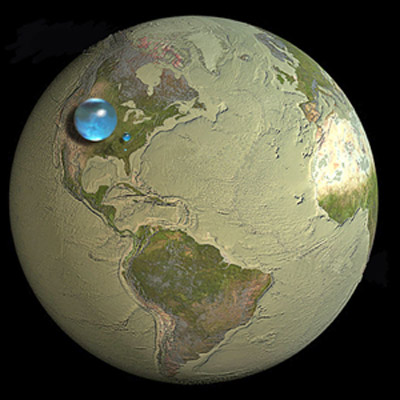
ga.water.usgs.gov contains interesting facts regarding the volume of water on our planet, startling when presented graphically. The large blue sphere is total water on earth and the small sphere is total freshwater, including in ice caps and ground water. The tiny blue speck is fresh water found in streams and lakes. Ground water accounts for 30% of all freshwater, inconsequential compared to the volume of seawater.
Some apologists suggest a source being ground water, erupting from the water table. This is based on Genesis 8:2 that mentions both "the springs of the watery deep and the floodgates of the heavens." However, rock does not float, and it was not possible for earth's continents to be suspended above oceans containing billions of cubic kilometres of water. It is estimated that for the volume of water required to cover earth's mountains to have been trapped in earth's crust, the porosity of the crust needed to be at least 50%, whereas the crust's porosity is less than 1%, due to the weight of the rock. 3 The volume of ground water today is only 1.69% of the total water on earth (ga.water.usgs.gov).
If it had been possible for such volumes of water to have been trapped under the crust, releasing it would have caused catastrophic changes to the earth's surface. This theory exacerbates several problems mentioned later, such as destroying all previous trace of civilisation, placing tremendous pressure on the ark, and contributing ongoing instability to the earth's surface well after the waters subsided.
Since, as mentioned before, there is negligible water in the atmosphere, where did the water go after the flood? The only other place are the ice caps, but if all ice melted, seas would only rise 70 metres (nsidc.org/cryosphere/glaciers 2 Jan 2013), catastrophic for coastal towns and island nations, but inconsequential in contrast to the 8,848 meter height of Mount Everest.
To account for where the water came from and where it went, the Watchtower paints a picture of a flatter earth, with Mountain ranges rising after the rain ceased.
“For the Flood to have happened, the pre-Flood sea basins would have to have been shallower, and the mountains lower than they are now. Is this possible? Well, one textbook says: “Where the mountains of the world now tower to dizzy heights, oceans and plains once, millions of years ago, stretched out in flat monotony. … The movements of the continental plates cause the land both to rear up to heights where only the hardiest of animals and plants can survive and, at the other extreme, to plunge and lie in hidden splendor deep beneath the surface of the sea.” Since the mountains and sea basins rise and fall, it is apparent that at one time the mountains were not as high as they are now and the great sea basins were not as deep.
What happened to the floodwaters after the Flood? They must have drained into the sea basins. How? Scientists believe that the continents rest on huge plates. Movement of these plates can cause changes in the level of the earth’s surface. In some places today, there are great underwater abysses more than six miles [more than 10 km] deep at the plate boundaries.16 It is quite likely that—perhaps triggered by the Flood itself—the plates moved, the sea bottom sank, and the great trenches opened, allowing the water to drain off the land." The Bible—God's Word or Man's? [1989] pp.112-113
This embarrassing display of pseudo-scientific takes scientific comments regarding the shift in continental plates that occur over millions of years, in an attempt to justify as scientific that the earth's mountains and seabed re-arranged within just a few years after a flood. By claiming the earth was considerably flatter during the flood, it is then proclaimed that "there was more than enough water".
"So, after the floodwaters fell, but before the raising of mountains and the lowering of seabeds and before the buildup of polar ice caps, there was more than enough water to cover “all the tall mountains,” as the inspired record says." it-1 p.610
This reasoning creates a catch-22. For a global flood to have any merit, the mountains had to be lower, as there is not enough water on earth to cover Mount Everest, whereas if mountains were lower than today, less water would be needed. However, this means after the flood there were monumental land transformations, with mountains being pushed up out of the floodwaters. Mountains usually grow at a rate of only millimetres per year, and even then the result of such movement can be earthquakes. For mountains to have grown thousands of metres over a rapid period, the resultant earthquake activity would have made the earth uninhabitable, in a state of constant, violent movement by earthquake and volcanic activity. What the waters had not destroyed, this continental reshaping would have, removing the majority of archaeological trace of life from any time prior to 4,400 years ago. Yet neither the Bible nor recorded history discusses such upheavals in the period after the flood. Modern earthquakes are almost inconsequential in comparison to what would be required for Everest to form after a flood just 4,400 years ago. Neither is this explanation consistent with the Genesis story, which describes the subsidence of water as being due to evaporation:
Genesis 8:1 "God caused a wind to pass over the earth, and the waters began to subside."

Consider too the rivers mentioned in Genesis. In the creation story, positioned over 1,500 years before the flood, Genesis 2:14 states that a river flowed from the Garden of Eden parted and became the Euphrates River. 400 years after the flood, the river Euphrates still existed, being mentioned at Genesis 15:18 in conjunction with Jehovah's covenant to Abraham. This is the same river running through the city of Babylon to this day. A global flood would have removed all trace of the river Euphrates.
Genesis 2:14 also mentions Assyria as existing prior to the flood, a country that continued to hold great significance throughout the Old Testament. If the flood had moved mountains and shifted continents, any countries and landmarks prior to the flood would have had no relevance and ceased to exist. For Assyria to remain, the magnitude of the flood could only have been of a minor scale.
Pyramids, Egypt and Civilisation
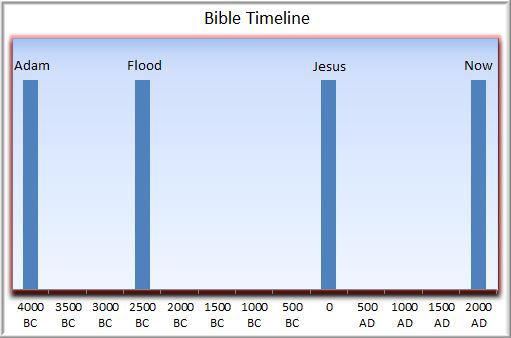
"The world that perished was civilized, with cities, artistic achievements, scientific knowledge. Yet, the Bible record tells us that suddenly, on the 17th day of the 2nd month, 352 years before the patriarch Abraham was born, a deluge began that swept away a whole world." Watchtower 2002 Mar 1 pp.3-4
A flood of a magnitude to shift mountains and move continents would have destroyed all man made structures and most historical records. This would mean archaeological finds and details of human history should only point back 4,400 years. This is not the case. Not only are there building and cities that date back more than 4,400 years, there are detailed documentation showing unbroken civilisations going back further than 5,000 years.
Egyptian history is well documented and supported by large volumes of archaeological finds. There was a thriving documented culture 1,000 years prior to the date determined for the flood, including evidence of language, hieroglyphics and an established Egyptian culture that was not destroyed by a flood. This history includes detailed records of the lineage of Egyptian Pharaohs back 5,000 years, to the start of the first dynasty in around 3,000 B.C. (See List of Pharaohs) The pyramid of Giza is generally accepted to have been completed around 2,560 B.C., 200 years before the flood supposedly occurred.
"471 feet [143 m] 2500 B.C.E. Pyramid of Khafre, Giza Egypt" Awake! 2002 Jun 22 p.18Not only was it not destroyed by the flood, it shows no sign of water damage.
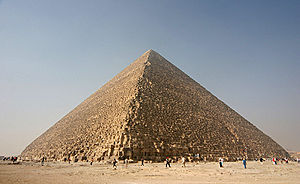
Apologist claims that the dating on Giza is wrong do not help. Building the pyramid of Giza, a structure containing almost 6 million tonnes of stone, required a significant sized city and governmental structure. If the flood had reduced the population to 3 child bearing couples, it would have taken many generations for a civilian population to reform to the size required to build the pyramid of Giza, placing the building of Giza many centuries after it is proven to have been built. Apologists cannot legitimately cast doubt on these dates, since Moses is accepted as writing Genesis in 1513 B.C., only 800 years after the flood, and discusses many thriving and competing cultures already in place, including Egypt and the Pharaohs.
It is not just the Egyptian civilisation that needs to be considered. English civilisation predates the global flood, with dendrochronology showing The Sweet Track in the Somerset Levels was constructed around 3,800 BCE and radiocarbon dating showing Stonehenge to be over 4,000 years old. These monuments not only indicate civilisation had not been wiped out by the flood, but that they were thriving by that period.
The largest ancient civilisation was the Indus Valley civilisation in India, and dates back to 3.300 B.C. Historical records for the Sumerian culture have been discovered that date back to 2,900 B.C. Mayans trace their history back to dates that precede the flood, with cities carbon dated to around 2,600 BC and a calendar starting from 3,114 B.C. One of the oldest civilisations is in China, with evidence of agriculture dating back thousands of years, with developed cultures 5,000 years ago and the Xia Dynasty by 2,100 B.C. The Chinese calendar begins 2,696 B.C. – 326 years before the flood.
Australian Aboriginals have been in Australia for tens of thousands of years, a figure agreed upon by carbon dating artifacts and genetic analysis. Budj Bim is a UNESCO World Heritage listed eel farming aquaculture site, consisting of wiers, channels and damms dating back 6,600 years.7
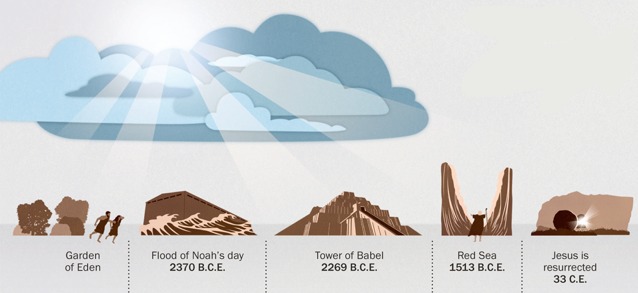
Even Bible genealogies dispute a global genocide. The Watchtower timeline from Watchtower 2014 Jan 15 p.10 shows the building of the tower of Babel occurred within 100 years of the flood. This is based on Genesis 10:25 and 11:10-19. Since only 8 people left the ark, this timeline expects us to believe Noah’s 3 sons had children, that these cousins interbred, and within a century there were enough first and second cousin construction workers to build a city, labourers to build the tower of Babel, and farmers to feed the population.
"The date of the attempt at building the Tower of Babel is not stated in the record. Genesis 10:25 indicates that the division resulting from the confusion of the languages there occurred sometime during ‘the days of Peleg.’ … which extended from 2269 to 2030 B.C.E. If each post-Flood male parent at the age of 30 were to begin fathering children at the rate of one child every three years, with an average of one male child every six years, and continued this until the age of 90, then in a period of about 180 years from the end of the Flood (that is, by 2189 B.C.E.) the population could have grown to a total of over 4,000 adult males. This conservative number would be ample to fit the circumstances relating to the tower construction and the dispersal of the peoples" it-1 pp.447-467 "Chronology"
The Watchtower calculates that 4,000 adult males were alive within 180 years of the flood. During this period of ancient building methods, prior to the efficiencies developed since the industrial revolution, construction of large buildings took thousands of people. It is estimated that Egyptian pyramids, a similar style building to the tower of Babel, took decades to build, using tens of thousands of men. (See pbs.org 4 Dec 2014) 2 Chronicles 2 shows the temple required 70,000 burden bearers, 80,000 stonecutters and 3,600 overseers. There simply would not have been enough people within one hundred years of a global flood to build Babel and its tower.
Nor to be forgotten is that during this time we are expected to believe there were enough people to build the pyramids of Egypt, as well as to disperse to China, India and the Americas, which as discussed above, all had thriving populations during that period of time.
Cave Paintings
French caves such as Lascaux and Rouffignac are filled with magnificent ice age art, including paintings and etchings of animals such as the mammoth, woolly rhino and cave bear. A global flood would have filled these caves with water and sediment, destroying all evidence of the paintings, yet these ancient images remain to this day.

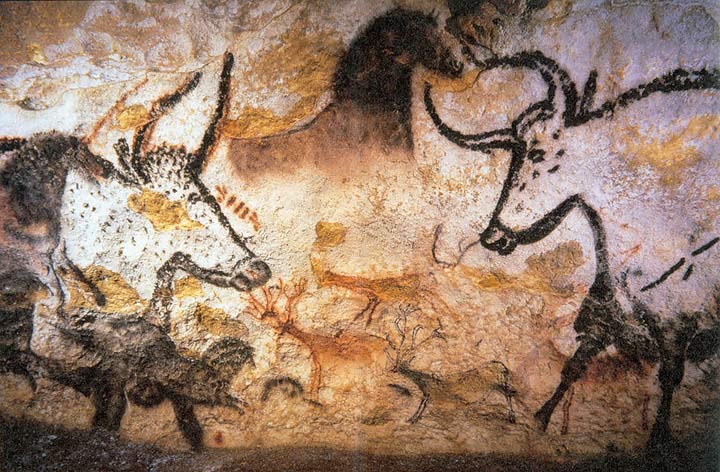
This elicits the question of why dinosaurs and ice age mammals were unworthy of an ark voyage, raising the quandary of whether the dinosaurs and ice age mammals had become extinct in the short period of time between creation and Noah or were excluded from the other ark going animals and perished in the flood.
Ancient carvings remain throughout the world, predating Noah and the tools needed to build an ark. Whilst Jehovah's Witnesses may disagree with the ages ascribed to this art, they predate the time of the flood, and would have been destroyed by a global flood.
"Of the other significant rock art sites in the world—from 7,000-year-old carvings in Norway to 25,000-year-old cave paintings in Brazil and 13,000-year-old paintings in Zimbabwe—none rival Murujuga for volume or continuity, he says. “What makes Murujuga special is the density and absolute amount of rock art,” Smith says. “The art also has a longer sequence than any of these other sites, extending from recent times back at least 40,000 years, probably 50,000 years." Pollution is threatening some of the world’s oldest rock carvings RONAN O’CONNELL APRIL 11, 2022
Further Issues
There is much else that cannot be explained by a global flood. For instance;
- Dinosaurs - People that take a global flood literally generally take the creative days literally and believe animal life was created either 6,000 years ago, or at least within the last 100,000 years. Hence dinosaurs are not believed to have died out millions of years ago. In that case, why weren't dinosaurs on the ark? What about Mammoths, which have been found frozen with food in their mouths? Noah was commanded to take two of every kind of animal.
- Where is the ark? - The Bible specifies the arks finally resting place as the mountains of Ararat, which is in Turkey. Many expeditions and the latest technology have never been able to locate the ark.
- Consistent temperature and air pressure - The animals resided together in the ark's confines, enduring the same heat and air pressure, whereas each have vastly different temperature and pressure requirements, and would struggle to survive in such conditions.
- Sediment - Around the world, silt has progressively settled into layers over millions of years. A global Flood would have coated the earth, and particularly seabeds, with an extraordinary depth of sediment, filled with the carcasses of billions of human and animal remains. The Watchtower quotes that a flood would result in water pressure "equal to “2 tons per square inch,” sufficient to fossilize fauna and flora quickly." (it-1 pp.609-612) No such layer of sediment and fossils exist.
Climatology
The study of historical climates disprove any drastic climate change less than 4,500 years ago. It also shows that the entire earth was not tropical, as a result of a cloud canopy.
Cores from ice caps and glaciers show no evidence of a flood. Ice cores going back tens of thousands of years are dated by counting annual layers. The National Ice Core Laboratory explains:
“Glaciers form as layers of snow accumulate on top of each other. Each layer of snow is different in chemistry and texture, summer snow differing from winter snow. Over time, the buried snow compresses under the weight of the snow above it, forming ice. (…) Ice cores are cylinders of ice drilled from ice sheets and glaciers. They are essentially frozen time capsules that allow scientists to reconstruct climate far into the past. Layers in ice cores correspond to years and seasons, with the youngest ice at the top and the oldest ice at the bottom of the core. By drilling down into the ice sheet or glacier and recovering ice from ancient times, scientists are able to determine the past composition and behavior of the atmosphere, what the climate was like when the snow fell, and how the size of ice sheets and glaciers have changed in the past in response to different climate conditions. Ice cores have provided climate and ice dynamics information over many hundred thousand years in very high, sometimes seasonal, resolution.” (icecores.org (as of 28 Dec 2015)

If the ice caps could have remained submerged under the floodwaters, it would have added a noticeable layer of sediment. In reality, the floodwaters would have floated the polar caps and melted them. These could not have been replaced within the last 4,000 years, and even if they could, would not display the annual layers that appear dating back hundreds of thousands of years.
Dendochronology is a highly accurate means of dating through the examination of tree rings, and can be aligned back over 11,000 years. (See Dendrochronology.) It is also used to show weather patterns by year and continent. Tree rings show no indication of a catastrophic flood.
The Rainbow

In Genesis 9:12-14, God gave the rainbow as a sign that he would not drown all humanity again by flood.
"And God added: “This is the sign of the covenant that I am giving between me and YOU and every living soul that is with YOU, for the generations to time indefinite. My rainbow I do give in the cloud, and it must serve as a sign of the covenant between me and the earth. And it shall occur that when I bring a cloud over the earth, then the rainbow will certainly appear in the cloud. And I shall certainly remember my covenant which is between me and YOU and every living soul among all flesh; and no more will the waters become a deluge to bring all flesh to ruin."
It is unrealistic to think the first rainbow appears after the flood, as it indicates that God changed scientific principles regarding refraction and reflection through water droplets. Nor are rainbows a product solely of rain. As they are caused by airborne water, a rainbow can also be a result of mist, spray, and airborne dew.
From the Watchtower point of view, it was also a hollow promise, as they depict God as being on the verge of destroying an even greater number of people at Armageddon, in even more violent ways. The Watchtower concept of Armageddon destroying the majority of mankind also conflicts with the Genesis story, where God promises:
Genesis 8:21 “Never again shall I call down evil upon the ground on man’s account, because the inclination of the heart of man is bad from his youth up; and never again shall I deal every living thing a blow just as I have done."
An Evil God
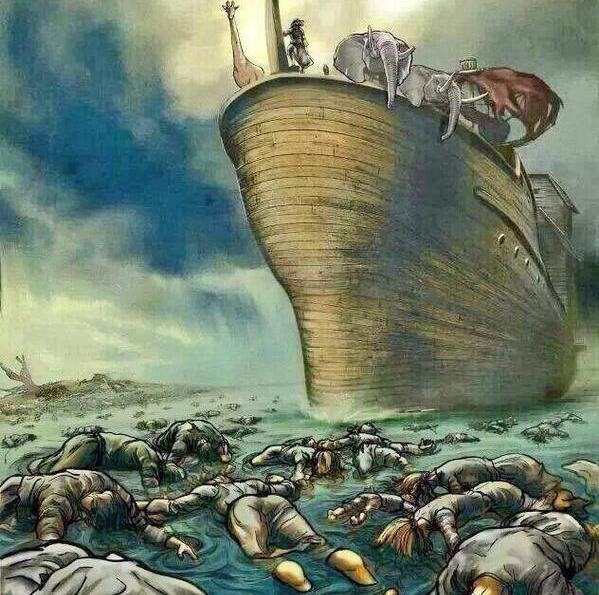
Lambert Dolphin and Gordon A. Hunt of Stanford University, estimate that there were potentially over 7 billion people on earth at the time of the flood. (ldolphin.org 1/1/2013) This is based on applying standard Population Growth Estimates to information in Genesis 5 of:
- A 1,600 year period between Adam and Noah
- Genealogies showing large families with at least 5 children
- Parents bearing children at several hundred years of age
- Humans living up to 1,000 years of age
Noah resided during a primitive period of time, without the means to warn any but his closest neighbours of the upcoming disaster. Billions of humans scattered throughout the earth would have been in utter shock at this first incidence of rain, having no idea they had been judged worthy of death by God.
Watchtower interpretation portrays a malevolent God, inhumanely drowning billions of adults, alongside innocent children and animals. Why was it necessary to drown trillions of birds, animals and insects? If humankind was so wicked as to deserve death, an almighty, loving God could have taken their lives painlessly, and without the need to destroy animal life as well.
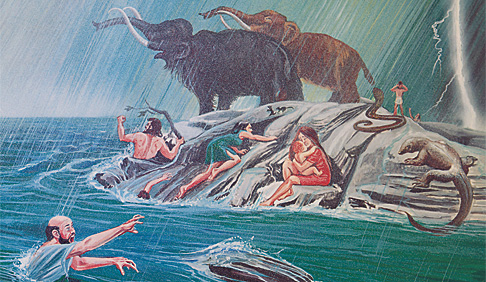
Image from My Book of Bible Stories Chapter 10
Apologist Refute
Watchtower has put little effort into trying to prove the legitimacy of a global flood. Support is limited to seashells appearing on mountains, the sudden death of animals such as frozen Mammoths or grouped fossils, and flood legends.
Seashells
"In the days of Noah, the Bible says, a great flood covered earth's highest mountains and destroyed all human life that was outside the huge ark that Noah built. (Genesis 7:1-24) Many have scoffed at this account. Yet seashells are found on high mountains." Life - How Did It Get Here? By Evolution or by Creation? pp.202-203
"Some see in this, as well as in such other things as marine fossils found on high mountains, convincing evidence of a sudden, catastrophic global flood." Insight on the Scriptures, Volume 1 p. 328
Seashells appear on mountain tops, not because of a flood, but because Mountains rise out of the sea through continental drift, as testified to in Psalms and acknowledged Watchtower publications.
"The mountains rise and fall, and today's mountains were once under the ocean. (Psalm 104:6,8) In contrast, several myths say that the mountains were created in their current form by the gods." Does Science Agree With the Bible? (as of 29 Jan 2020.)
Fossils and Mammoths
Whilst the following quotes tentatively posture that fossils and frozen mammoths could indicate rapid death in a global flood, there is also the admission this not really proof as death could have been by other causes.
"Another evidence for the Flood appears to exist in the fossil record. At one time, according to this record, great saber-toothed tigers stalked their prey in Europe, horses larger than any now living roamed North America, and mammoths foraged in Siberia. Then, all around the world, species of mammals became extinct. At the same time, there was a sudden change of climate. Tens of thousands of mammoths were killed and quick-frozen in Siberia. Alfred Wallace, the well-known contemporary of Charles Darwin, considered that such a widespread destruction must have been caused by some exceptional worldwide event. Many have argued that this event was the Flood." gm pp.114-115
"What evidence proves that there truly was a global deluge?
Other possible evidence of a drastic change: Remains of mammoths and rhinoceroses have been found in different parts of the earth. Some of these were found in Siberian cliffs; others were preserved in Siberian and Alaskan ice. In fact, some were found with food undigested in their stomachs or still unchewed in their teeth, indicating that they died suddenly. It is estimated, from the trade in ivory tusks, that bones of tens of thousands of such mammoths have been found. The fossil remains of many other animals, such as lions, tigers, bears, and elk, have been found in common strata, which may indicate that all of these were destroyed simultaneously. Some have pointed to such finds as definite physical proof of a rapid change in climate and sudden destruction caused by a universal flood. Others, however, favor explanations for the death of these animals that do not involve an earth-wide catastrophe. Proof that the Flood occurred is not dependent on such fossils and frozen animal remains." it-1 pp. 610-611
The fossil record does not support a flood, as animal extinction events appear in layers that can identified as occurring thousands and even millions of years apart.
Mammoths are poor proof for a flood, as snap frozen food in a Mammoth's mouth indicates an icy event such as dying in a blizzard or falling through a frozen lake. Mammoths continued to live after the flood, surviving on Wrangel island until 1,650 B.C. Their speared remains exist throughout the world, making one wonder how Noah reached all these hunters in order to warn them about their upcoming demise at the hands of his God.
"Noah warned people that the Flood was coming, but they did not listen to him." You Can Be God's Friend! Lesson 7
Flood Legends
The Watchtower claims that the vast number of flood legends is "proof" of the flood of Noah.
"The fact that there are not merely a few but perhaps hundreds of different stories about that great Deluge, and that such stories are found among the traditions of many primitive races the world over, is a strong proof that all these people had a common origin and that their early forefathers shared that Flood experience in common." it-1 pp.609-612

Insight on the Scriptures p.328
Whilst an interesting point, a multitude of flood legends do not constitute "proof". Since floods affect most populated areas of the earth, it is to be expected that floods would feature in the traditions of primitive races. These stories vary in many points, leading to the conclusion that most are not predominantly related to the same occurrence.
There is a set of remarkably similar Ancient Near Eastern Flood Legends. Some predate the Genesis account and it is generally accepted by scholars that the Genesis account draws from these sources. The Flood of Genesis follows the Flood of Gilgamesh "point by point and in the same order."5
- Sumerian Eridu Genesis of Ziusudra 17th Century BC
- Atrahasis ca. 1630 BC
- Epic of Gilgamesh Tablet Eleven ca. 2000–1500 BC 6
- Genesis ca. 1513 BC
- Berossus
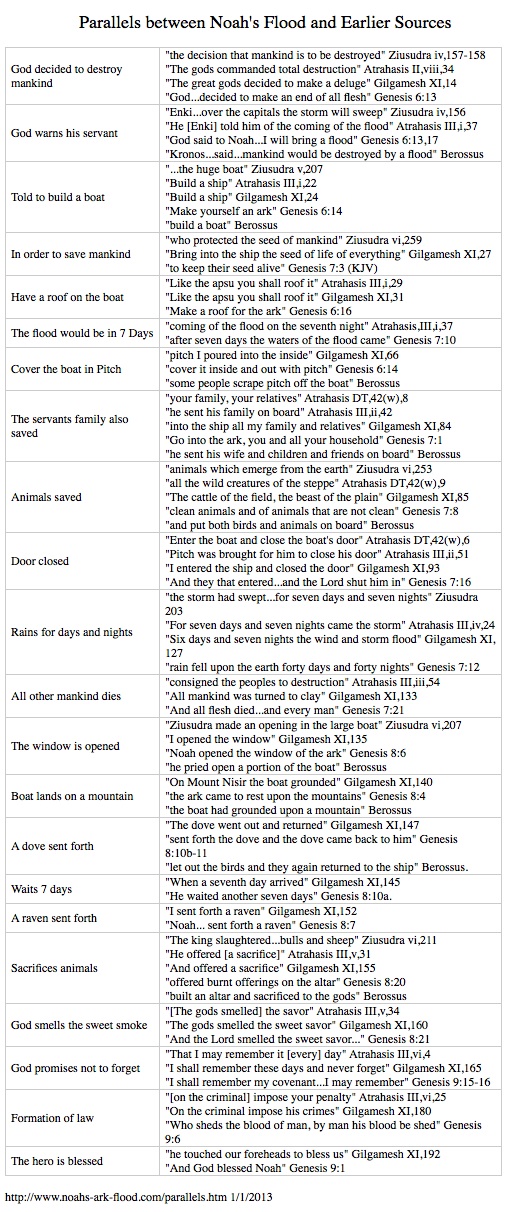
It is no surprise that stories abound of great floods. Following the last glaciation just over 10,000 years ago, there were devastating floods around the globe as the ice sheets started to melt. See Discover Magazine (sited 7 April 2018).
As discussed at THE FLOOD & FLOOD LAKES: MESOPOTAMIAN ARCHAEOLOGICAL EVIDENCE & COVER UP (MARCH 20, 2016) by David MacDonald Ph.D., archeologists such as Woolley, Langdon and Watelin uncovered evidence of great floods in the Mesopotanian region, such as during the Early Dynastic III era around 2600 BCE that could be the basis of local flood legends.
As there is no proof of a global flood, apologists seize upon sensational articles that seem to support one, such as the following.
Proof the flood behind Noah's biblical legend actually happened.
Robert Ballard, an acclaimed underwater archaeologist, has talked about his findings with a US news outlet after scouring the depths of the Black Sea off the coast of Turkey with advanced robotic technology in search of traces of an ancient civilisation. Ballard said he now supports a theory first put forward by scientists from New York's Columbia University that the Black Sea was once a freshwater lake surrounded by farmland before being overrun by "an enormous wall of water" from the rising Mediterranean Sea. Ballard told ABC News that evidence of an ancient shoreline suggests a "great flood" may have taken place around 5000 BC. He said thousands of years ago much of the world was covered in ice. But when it started to melt, the water began to rush toward the world's oceans, causing floods all around the world.
… The theory suggests that the story of the flood was passed down from generation to generation and eventually inspired the biblical account of Noah. (ninemsn.com.au 12 Dec 2012 - see also abcnews.go.com)
Whilst the heading seems to support Noah's flood, the article shows otherwise. It discusses great flooding around the world, not as a result of rain, but from the ice caps melting after the end of the last ice age. An example of Watchtower misrepresenting this type of information was published in 2008.
"Geologists studying the landscape of the northwestern United States believe that as many as 100 ancient catastrophic floods once washed over the area. One such flood is said to have roared through the region with a wall of water 2,000 feet high, traveling at 65 miles an hour, a flood of 500 cubic miles of water, weighing more than two trillion tons. Similar findings have led other scientists to believe that a global flood is a distinct possibility." Watchtower 2008 Jun 1 p.8
Really? Which scientists, and what portion of the scientific population do they represent? There is evidence of great floods, but not of floodwaters covering the highest mountains. These floods, affecting many regions around the world, are the reason for the multitude of flood legends from many diverse cultures, but are not evidence of a global flood.
As a last resort, apologists for a global flood will cast doubt on the accuracy of the information, such as dating methods. Yet carbon dating is demonstrably accurate to over 10,000 years through verification with dendrochronology, well beyond the time frame of Noah's flood.
Where there is no possible refute, the common response is that with God all things are possible. For instance, maybe God added extra water specifically for the flood and then removed it afterwards. God may have transported all the animals to the ark and then back to their local region. Maybe God hibernated the animals, so there were no issues with a shortage of food, water, or abundance of manure. If resorting to magical thinking is a valid response, then for that matter, God could have reduced the entire global population of animals to the size of Lego men and teleported all onto the ark. Really though, if such a range miracles were required, why not use a more humane method of murder? Why make innocent animals suffer drowning, when the wicked could have been put to death in their sleep, without the catastrophic destruction of animal life? A global flood requires God violate his laws of physics and then erase the evidence. Why all the effort for a story that many millenniums later would be unlikely for any educated person to believe?
Scriptural Collaboration
As there is no evidence for a global flood, Watchtower's main proof is simply that the Flood of Noah is verified by being referred to by several Bible writers, and Jesus himself.
"Stronger evidence of the historicalness of the Deluge than the pagan traditions of primitive people is the endorsement other Bible writers gave under inspiration." Insight on the Scriptures, Volume 1 p.611
"The fact that the Flood really occurred is verified by a number of Bible writers. (Isa 54:9; 2Pe 3:5, 6; Heb 11:7) The strongest evidence, however, is the testimony of Jesus Christ himself, who was an eyewitness in the heavens. (Compare Joh 8:58.) He pointedly said: "In the days of Noah, ... the flood arrived and destroyed them all." - Lu 17:26, 27.
The account of the Flood is far more than a story. Jesus Christ indicated that it has prophetic significance. In his prophecy about "the conclusion of the system of things," he made specific reference to "the days of Noah." He pointed to the Flood as a warning example of a greater destruction to come during "the presence of the Son of man."" Insight on the Scriptures, Volume 1 pp.327-328
Is that really the case? If a global flood is proven beyond doubt not to have occurred, does the story being in the Bible override all evidence.
Alternate Christian viewpoints
It is noteworthy that some Christian groups reconcile the flood of Genesis without breaching reality. There are two main lines of thought;
- the flood was not meant to be taken literally
- the flood was local
Firstly, and quite simply, it in not necessary to conclude that the flood legend was meant to be taken literally. Rather, its inclusion in Genesis was as a moral lesson, and referred to in the New Testament for the same reason.
The second line of reasoning is that Noah's flood was a localised event; limited to the region Noah was in. The Hebrew word 'erets can be translated as earth or land and har can be translated as either hills or mountains. This can lead to the understanding that the flood covered the highest hills within the region. The statement at Genesis 6:17 that God destroyed "all life under the heavens" is common terminology in the Bible for occurrences that were localised, such as the famine at the time of Joseph, where Genesis 41:57 states, "people of all the earth came to Egypt to buy from Joseph", or Deuteronomy 2:25 that "the peoples beneath all the heavens" lived in fear after Joshua conquered Canaan.
A local flood also removes the theological issue that a global flood contradicts Psalms 104. This passage is a parallel of the Genesis account of creation, and states in verse 9 that after God caused dry land to appear during the creation process, water would never again cover the entire earth.
Psalms 104:6-9 "With a watery deep just like a garment you covered it. The waters were standing above the very mountains. At your rebuke they began to flee; At the sound of your thunder they were sent running in panic — Mountains proceeded to ascend, Valley plains proceeded to descend — To the place that you have founded for them. A boundary you set, beyond which they should not pass, That they should not again cover the earth."
A local flood does away with the issues raised above that make the story simply impossible. For example, Noah could only warn people in the local vicinity. Animals could only make it to the ark that lived within a reasonable distance. Every animal globally could not fit on the ark, whereas the variety of animals within the area may have. The ark remained in the local vicinity, and the same rivers still existed after the flood.
The following map shows the proximity of Mt Ararat with the fertile crescent. Mesopotamia, meaning “land between the rivers” in Greek refers to it being between the Euphrates and Tigris Rivers. This area is used as the settings for the Garden of Eden and Noah's ark.
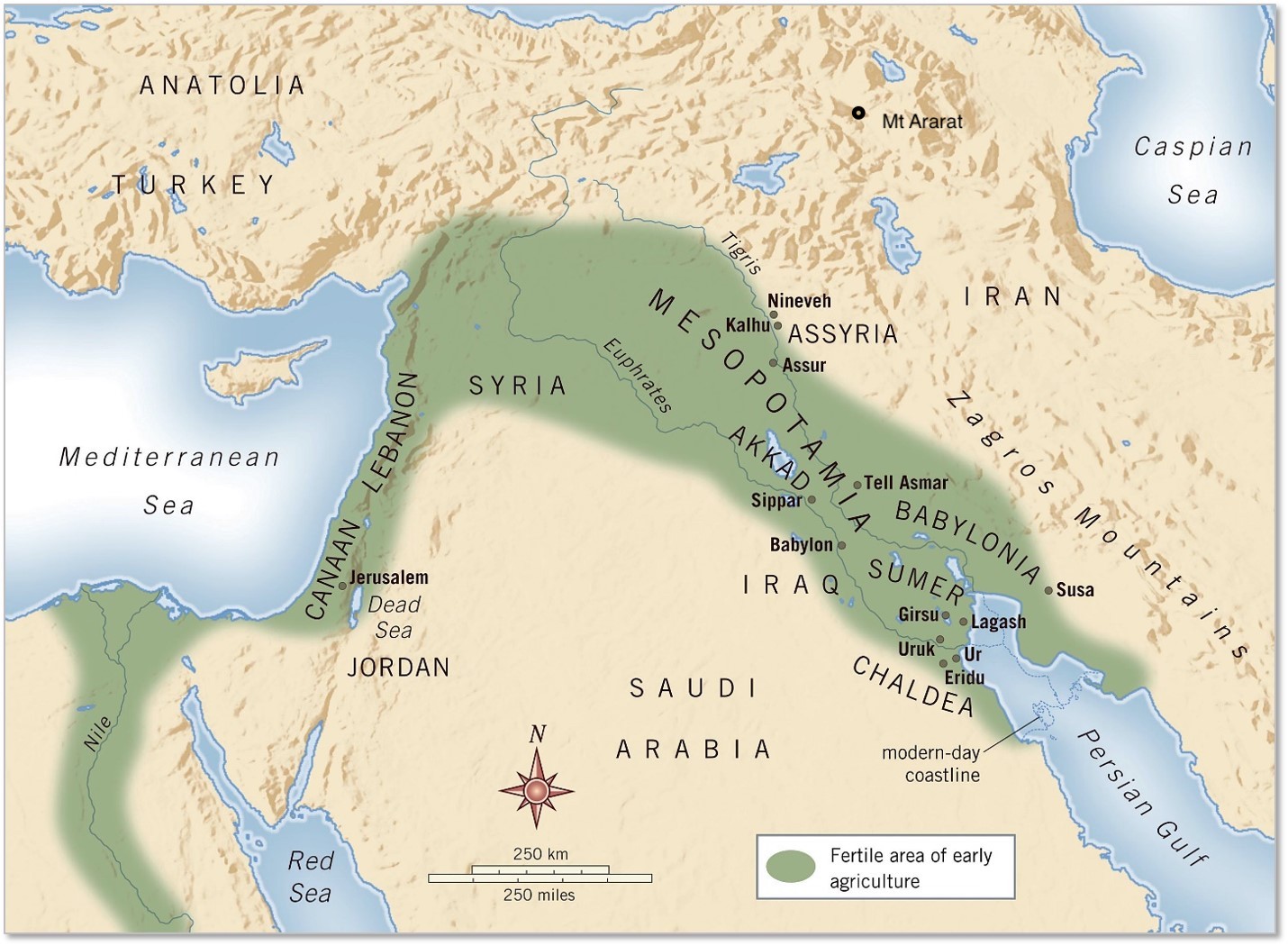
Conclusion
This has been a simple summary of facts regarding a global flood. Though brief, most people reading the information will understand that a global flood never occurred. For people wanting more information, there are many books filled with detailed scientific discussion disproving a global flood.
Through this article, you will have noticed the insular nature of Watchtower justification for issues raised by a global flood. They regularly contradict justification of other issues, or even the Bible passage itself. It is a classic example of not seeing the forest from the trees. For example, to justify where the water came from, the earth is said to have been flatter. But the resultant rising of mountains after the flood creates other more problematic concerns.
When taken literally, as by Jehovah's Witnesses, there is not a single aspect of this story that cannot be proven to be false. It is remarkable that the Watchtower still clings to a literal global flood, when this is proven false by virtually all fields of endeavour, including anthropology, archaeology, astronomy, astrophysics, biology, botany, chemistry, climatology, ecology, engineering, entomology, genetics, geology, geography, linguistics, meteorology, microbiology, palaeontology, physics, seismology, theology and zoology. Yet even without an understanding of these areas, there can be no doubt as to the impossibility of a global flood through the use of common sense alone.
Several hundred years ago it understandable that people may have accepted a global flood as literal, but it is almost incomprehensible that a person educated in the twenty first century would take this ancient story literally. Christians may have accepted the story of a global flood a few hundred years ago, whilst the Church was still teaching that earth was flat, and unaware of the amazing scientific discoveries over the last two centuries. We now understand in great detail the movement of the planets and gravity, the size of the earth and mountains, and the constitution of life forms. Physics, chemistry, and biology have progressed to the point that we have space travel, air flight, wireless communication and advanced medicine, and each of these sciences prove that a global deluge is simply impossible. In this day and age it is unbelievable that any religion would teach that a global deluge actually occurred, particularly one that labels itself as God directed and the truth.
If this Watchtower doctrine is not truth and was not guided by God, what other Watchtower doctrine does God not direct? Doubt is cast on all Watchtower doctrine.
References
1. L. Vardiman and K. Bousselot, “Sensitivity Studies on Vapor Canopy Temperature Profiles,” Proc. Fourth ICC, 1998, pp.607-618.↩
2. Soroka, Leonard G. and Charles L. Nelson, 1983. Physical constraints on the Noachian Deluge. Journal of Geological Education p.135↩
3. Soroka, Leonard G. and Charles L. Nelson, 1983. Physical constraints on the Noachian Deluge. Journal of Geological Education p. 197↩
4. Camilo Mora, Derek P. Tittensor, Sina Adl, Alastair G. B. Simpson, Boris Worm. How Many Species Are There on Earth and in the Ocean? PLoS Biology, 2011; 9 (8): e1001127 DOI: 10.1371/journal.pbio.1001127
plosbiology.org How Many Species Are There on Earth and in the Ocean? Camilo Mora, Derek P. Tittensor, Sina Adl, Alastair G. B. Simpson, Boris Worm (as at 28 Sep 2012) ↩
5. Rendsburg, Gary. "The Biblical flood story in the light of the Gilgamesh flood account," in Gilgamesh and the world of Assyria, eds Azize, J & Weeks, N. Peters, 2007, p.117↩
6. Andrew George, page 101, “Early Second Millennium BC” in Old Babylonian↩
7.
Aboriginal Australian mitochondrial genome variation - an increased understanding of population antiquity and diversity Mar 13 2017
Ancient Indigenous aquaculture site Budj Bim added to UNESCO World Heritage list 6 Jul 2019
Further information
Problems with a Global Flood - Mark Isaak
ncse.com/cej/4/1/impossible-voyage-noahs-ark
10 Interesting Facts about Noah's Ark
A video discussing the impossible maths required by the flood.
Ukrainian translation of this article.
Written 2003, latest update Aug 2022.
![]() Paul Grundy 2005 - 2026
Paul Grundy 2005 - 2026

